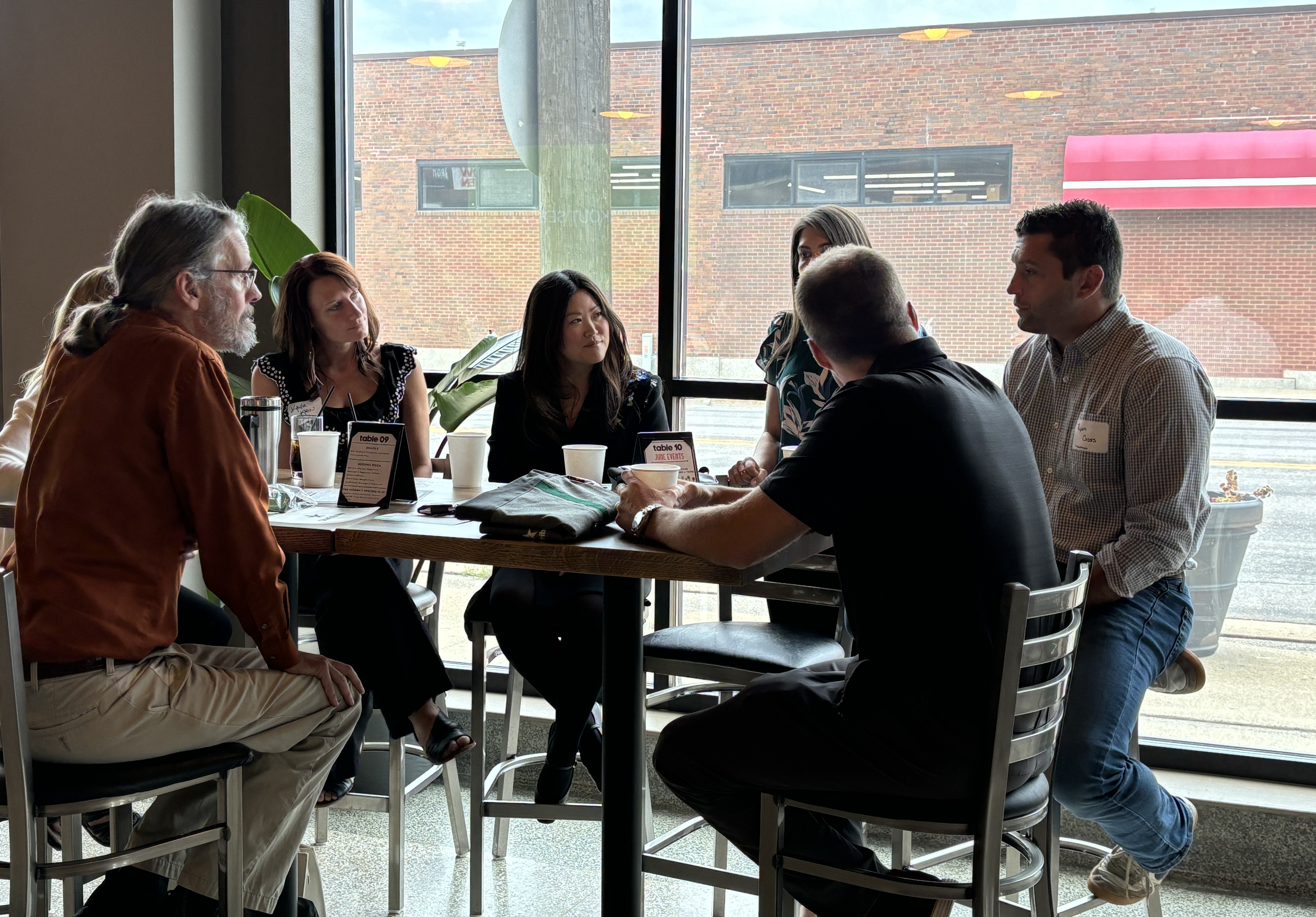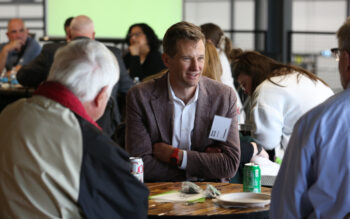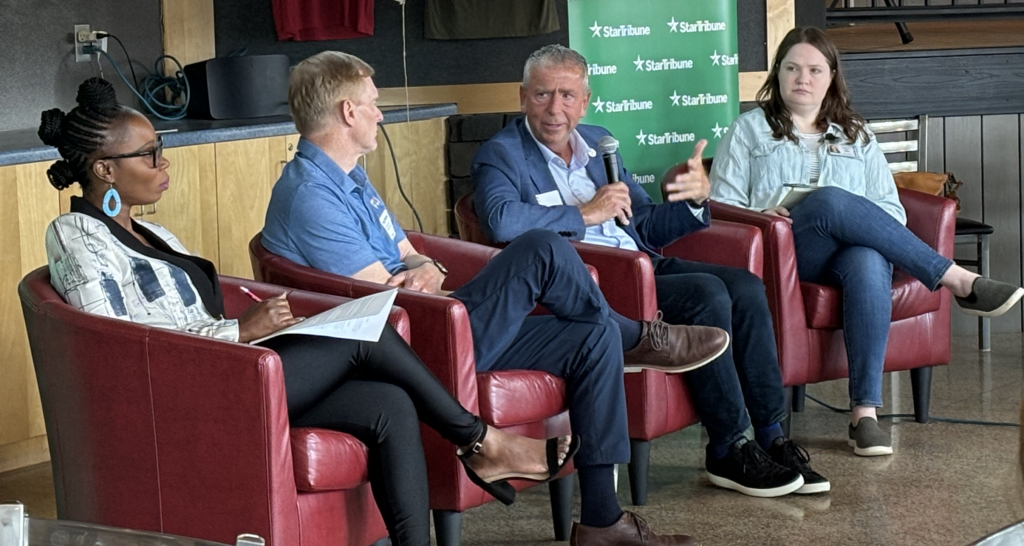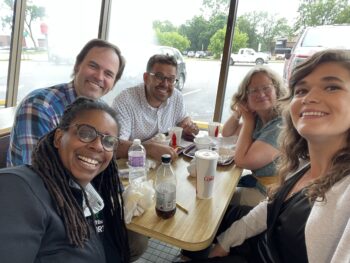How the Minnesota Star Tribune built relevance, one community at a time
Kyndell Harkness, Minnesota Star Tribune,
St. Cloud community members talk through two questions posed at all of the Minnesota Matters events, “What should the rest of the state know about this community?” and “What do people and/or the media get wrong about this community?” (Photo by Kyndell Harkness/Star Tribune)
Here’s an idea to steal and adapt: Organize a series of events (with wide-ranging topics) in communities across your state to build your news organization’s relevance.This is a series on Better News to a) showcase innovative/experimental ideas that emerge from the Knight-Lenfest Newsroom Initiative and b) share replicable tactics that benefit the news industry as a whole.
This “win” comes from Kyndell Harkness, head of culture and community at the Star Tribune, which participated in the Major Market Table Stakes program in 2015-16 and API’s Digital Subscriptions Sprint for Table Stakes Alumni in 2022.
Question: What problem were you trying to solve, and why was that problem strategically important to your organization?

Minnesota Star Tribune CEO Steve Grove (Photo by Kyndell Harkness/Star Tribune)
A: We knew we couldn’t call ourselves The Minnesota Star Tribune when the state didn’t feel like they knew us. In April 2023, our new CEO, Steve Grove, took a tour of Minnesota and realized that The Star Tribune was viewed as just another company and not as people. (Grove is also a board member for the American Press Institute, which runs Better News.)
Minnesotans were asking for stories we were already producing, but they weren’t finding them. The problem we were solving for was relevance. If we are not relevant to our communities, then what hope do we have of surviving?
Q: How did you go about solving the problem?
A: The first step to relevance is building relationships. After Grove’s first statewide tour, we knew we had to grow our reporting muscle throughout Minnesota. Our reputation was that The Star Tribune was for the Twin Cities and not the state. To break through that perception, we needed our new relationships to be authentic, which meant spending time with folks and listening to their stories.
The Minnesota Matters series, which started in March 2024, was an integral part of our expansion. We picked six population hubs to be the host communities for events that included journalists, editors, community leaders and subscribers. Over breakfast or lunch, we facilitated panel discussions followed by small group conversations about what makes their community unique. With a Strib employee in every group, the community members’ stories were written down and shared at the end.
Along with our regional community events, we also had advertising events the same day. Our sales and marketing team hired local sellers in these areas and had their own programming to convince local businesses to support the journalism in their community. Combining the two efforts, The Star Tribune hosted 12 events with 281 guests
We will be doing listening sessions for each of the five restructured news departments. We’ve begun that work with a food Minnesota Matters event this summer. There will also be community discussions after the release of a podcast series that delves deeper into the history of the Black experience in Minneapolis.
For 2025, the plan is to return to the six regional communities with the goal of going deeper and inviting more of the public to participate, and to add some smaller towns to make sure we are reaching real rural voices.
The goal is also to be nimble. Any time news flares up or if a community has issues with The Star Tribune, we want to be able to respond quickly to open up a dialogue in a common space. We want to always be talking with the state.
One of our state-wide reporters, Reid Forgrave, was able to pen a story about local governments dealing with divisive national politics.
Community and Engagement Director Kavita Kumar, who had attended most of the Minnesota Matters events said, “I have been making contacts and building up a roster of potential op-ed contributors from around the state from these events. I am also hoping to write a column myself about some of the conversations and discussions I’ve had at these meetings.”
Food reporter Joy Summers said, “It was an opportunity to open a dialogue that wasn’t transactional. We could ask for constructive criticism and foster engagement in the stories we tell beyond the standard news bites. Also, everyone reads 5 Best. Lots of praise for the diversity of restaurants, regions and price points.”
We showed up in numbers. We listened to people and demonstrated that we heard them. Reporters left with story ideas, editors left with a deeper understanding of who these Minnesotans were, and local guests left feeling good. Those communities we saw during Grove’s first state tour were pleasantly surprised that we came back. Showing up consistently is a part of building relationships and relevance.

St. Cloud Mayor Dave Klies answers a question from Star Tribune reporter Jenny Berg (right) during a panel discussion at the Minnesota Matters event in St. Cloud. The Q&A at the beginning is a way to spark livelier discussions in the small groups during the second half of the event. (Photo by Kyndell Harkness/Star Tribune)
Q: What worked?
A: First, there is power in going to where people are instead of making them come to you.
Second, breakout sessions are an effective means of capturing all voices. Those who were reluctant to raise their hand in the large crowd were more comfortable speaking up in their small groups. People really bounced ideas around their tables and played off of one another.
Finally, we capped the event at 40 guests. We wanted to keep each gathering small so that real talk could happen. As an extra bonus, this allowed us to sell out our last two events.
Q: What didn’t work?
A: Foremost, I wanted more diversity in our guests. Greater Minnesota is no longer as racially homogenous as it once was, and Indigenous voices have been absent from the Minnesota narrative. Although we made an effort, particularly with tribal communities, there was a very small turnout. It may take some specific community listening to build trust.
I also wanted more companywide engagement. It’s so healthy for our journalists to sit with ordinary people and let their curiosity lead them, without having to produce or edit. That kind of engagement is a gift. Regional reporters and editors came to events hosted in their community but only a smattering of others showed up.
Q: What happened that you didn’t expect?
A: I didn’t expect to be thanked. So many of our guests gleefully shook our hands, sent us emails and exchanged contact information. It really showed us the power of being present in a non-transactional way.
“The desire to serve the entire state is proving to be sincere and authentic, and here on the border to North Dakota, it is being noticed!” Moorhead Mayor Shelly Carlson shared. “The City of Moorhead team found it useful to hear from citizens thoughts and insight regarding their ideas of ‘newsworthy’ topics in addition to having the Trib demonstrate this area is just as significant and important as other areas.”
I was struck by the similarities in what people wanted for their communities. Affordable housing, childcare and economic development were universal concerns.
Q: What advice would you give to others who try to do this?
A: Sit in discomfort. No matter if the “community” you’re listening to is a place or a people, they will have history with you. They will come with preconceived notions, and sometimes they will come with anger. Own your history and ask for a do-over. Be better and follow up.
Communicate! We keep a database of all Minnesota Matters attendees, and we send out thank-you emails. We are keeping in touch as an organization.
Q: What’s next for this work?

Kyndell Harkness (from left), head of culture and community, regional reporters Chris Vondracek and Reid Forgrave, State columnist Karen Tolkkinen and regional reporter Kim Hyatt take a selfie after lunch at Mickey’s Pizza and Subs after a Minnesota Matters event in Brainerd. Often, reporters and editors chat afterwards about what they learned and what they want to follow up on. Especially for our regional reporters, who don’t come into the office regularly, it gives them an opportunity to be in community with each other. (Photo by Kim Hyatt/Star Tribune)
A: We are becoming better listeners. We are beginning to reach out to marginalized communities before publication to share general themes and get advice on tone for projects that involve them. We want to keep experimenting with how that could change long-form journalism.
We are exploring partnerships with other media organizations around the state when we have shared questions.
We are empowering communities to work together toward common goals. The Minnesota Star Tribune works to be a convener by helping communities come together to solve their own problems.